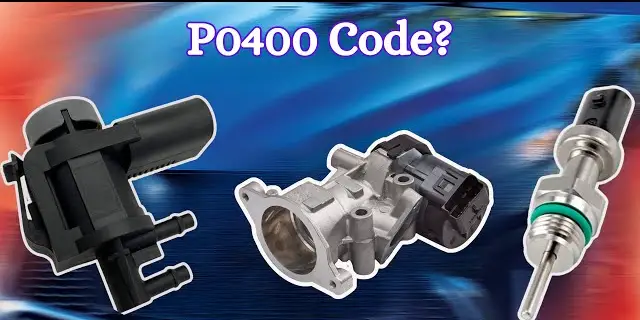P0400 Code: Causes, Symptoms, and the best Fixes for EGR Flow Malfunction

🚗 What Is the P0400 Code?
Understanding the P0400 Code: A Deep Dive into EGR System Failure
The P0400 code is one of the most common OBD-II trouble codes related to the Exhaust Gas Recirculation (EGR) system. When your vehicle’s onboard computer detects insufficient or irregular flow in the EGR circuit, it triggers this code, signaling a potential issue that could affect engine performance, fuel efficiency, and emissions compliance.
❓ Why Does the P0400 Code Appear?
The code is stored when the ECM detects the EGR system isn’t working properly. The EGR helps reduce nitrogen oxide (NOx) emissions by recirculating some exhaust gas back into the combustion chamber, lowering combustion temperature. Disruptions in this process (like carbon buildup or mechanical failure) cause the ECM to log this code and turn on the Check Engine Light 🔧.

🔍 Key Factors Behind the P0400 Code
- Clogged EGR Valve or Passages – 🧼 Carbon deposits block the flow.
- Faulty EGR Valve – 🔄 Stuck open or closed.
- Defective EGR Solenoid or Vacuum Control – 🧪 Solenoid or vacuum issues.
- Failed Sensors (DPFE, MAF, MAP) – 📉 Incorrect sensor readings.
- Electrical or Wiring Problems – 🔌 Damaged wires or poor connections.
⚠️ Why You Should Address It Immediately
- 📉 Reduced fuel economy
- 🌫 Increased emissions
- 🚦 Engine performance issues: rough idle, hesitation, or stalling
🛠 Diagnostic Tips
- 🔍 Examine wiring and connectors for corrosion or looseness.
- 📟 Use an OBD-II scanner to confirm and check related codes.
- 🔧 Inspect the EGR valve for blockage or mechanical failure.
- 🧪 Check vacuum lines and solenoids for leaks.
- 🧠 Test EGR-related sensors (DPFE, MAF, MAP).
📋 Common Symptoms
- 💡 Check Engine Light on
- 🐢 Reduced engine power
- 🚗 Rough idling or stalling
- ⛽ Increased fuel consumption
- 🚫 Failed emissions test
🧾 Possible Causes
- Faulty or Clogged EGR Valve – Carbon buildup or stuck valve.
- Blocked EGR Passages – Soot clogging gas flow.
- Defective EGR Solenoid/Vacuum Control – Poor EGR activation.
- Faulty Sensors – Incorrect readings confuse the ECU.
- Electrical/Wiring Issues – Bad connections disturb signals.
- Exhaust/Intake Leaks – Pressure and flow problems.
🧰 How to Fix It
- Clean or Replace the EGR Valve – Use cleaner or install new.
- Clear EGR Passages – Remove carbon deposits.
- Check and Replace Sensors – Use a scan tool for readings.
- Inspect Electrical Connections – Fix broken or corroded wires.
- Verify Vacuum Lines – Look for cracks or leaks.
- Check for Leaks – Inspect gaskets, hoses, EGR cooler.
👨🔧 Professional Help
✅ Conclusion
The P0400 code signals a problem in the EGR system—often due to carbon buildup or sensor malfunction. Proper diagnosis and repair will restore performance and reduce emissions. 🔧 Regular maintenance helps prevent recurrence. 🧼🌍

The EGR system plays a crucial role in reducing harmful emissions, but it can be prone to issues like carbon buildup. When the ECM detects a problem, it logs a code and alerts the driver via the Check Engine Light. Regular maintenance can help prevent disruptions in the EGR system. What steps can be taken to minimize carbon buildup in the EGR valve?
To minimize carbon buildup in the EGR valve, use high-quality fuel, perform regular engine oil changes, drive at highway speeds periodically to allow higher EGR flow, and clean or replace the EGR valve as part of routine maintenance.
The EGR system is essential for reducing emissions, but it can face issues like carbon buildup. Regular maintenance, such as cleaning the EGR valve, can help keep it functioning properly. Using high-quality fuel and driving at highway speeds can also minimize carbon deposits. What are the signs that the EGR valve might need cleaning or replacement? German news in Russian (новости Германии)— quirky, bold, and hypnotically captivating. Like a telegram from a parallel Europe. Care to take a peek?